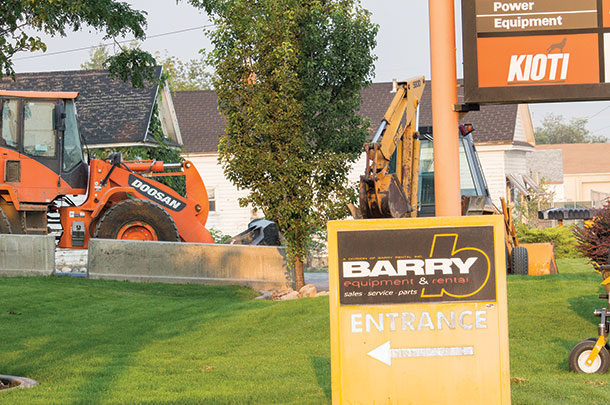For teenagers, they of course want everything and have an impossible time even conceptualizing the difference between wants versus needs.
With fields full of corn, beans or hay, the analysis of wants and needs is more complex. You want to harvest the product in the most efficient way possible to maximize yields, minimize damage and with the lowest inputs of fuel and time.
Which brings up a whole host of questions: Do I have the tools and technology to achieve that or do I “need” something else that will achieve those objectives better, faster or at lower cost? Should I rent that? Do I buy now or wait? What’s the best use of my capital today? Do I need to be thinking longer-term?
According to the latest data from the Association of Equipment Manufacturers, recent sales of new under-40 and 40 to 100 horsepower tractors jumped to 10- and eight-year highs, respectively.
While that’s good news, investments in production machinery, larger (more than 100 horsepower) tractors and self-propelled combines continue negative year-over-year sales trends. This tells us that farmers are holding on to their larger-production equipment longer, looking on the used market, renting equipment or contracting out selected farming activities.
In the construction sector, with the 2008 to 2012 recession, purchase of new equipment dropped off precipitously, with a crowded used equipment market holding down prices. A skittish economic recovery led in recent times to an uptick in rental activity as contractors chose to rent rather than own at least some machines or equipment.
Rental agencies tend to turn their equipment faster so you can generally have access to newer model machines rather than relying on “Old Faithful” (a 20-year-old tractor). It’s also a good way to test-drive a machine to see if it would be something to purchase.
Renting equipment passes on the risk of new technology investments and costs of service and maintenance to the rental company, but the farmer is at the mercy of equipment supply and demand.
Will there be a machine or piece of equipment available when he needs it? What happens if it breaks down in the middle of a narrow harvesting window or late at night in the middle of a field before a rainstorm? Other upsides of renting include not tying up capital in longer-term financing arrangements, keeping capital free to invest in other areas of the farm.
For some farming activities, equipment rental or contracting out full services is well-established. Combine harvesters represent one of the largest investments of a single machine – hundreds of thousands of dollars for use only a few days or weeks each season. Contracted harvesting services have long been the norm for the largest farms.
With weather influences and labor shortages in some areas, getting crops off the field is a time-sensitive activity, where contracted services can bring scalability of multiple harvesting units and manpower that would not be justified for an individual farmer. The downside is, of course, higher harvest prices and some loss of control.
One look at some used equipment websites for harvesters and combines suggests that there is an ample inventory of used 1-year- to 5-year-old equipment, ranging up to $279,000 for a top-of-the-line combine with low hours.
Combine harvesters generally sell new in the lowest volumes, such as when July 2015 sales were just 511 total units in the U.S., and that was down 34 percent from 2014, according to Association of Equipment Manufacturers. That fact taken together with annual sales trends suggests that more of the larger lower-use machines are not being replaced nearly as often, if at all, or their services are being contracted out.
In making decisions on renting or owning, where and when you rent or look for a used machine is like politics; they are all local. For example, a recent analysis found a 67 percent increase in resale volume in self-propelled forage harvesters as documented by the USDA, according to EquipmentWatch.
This analysis also showed clearly that the Midwest has the largest concentration of forage harvesters, while the southeastern U.S. has the lowest amount. Equipment markets are very regionally driven; where there are more units available, prices will be lower.
There are no hard-and-fast rules of thumb for owning or renting equipment. Rental contracts can be bought with maintenance and service agreements, damage waivers, etc. With so many types of equipment out there, every farmer must make the decisions best for the individual operation.
Recently, average monthly cost to own versus rent data from EquipmentWatch suggested something counter-intuitive – that across 48 different subtypes of construction equipment, ownership costs per month tend to be about 5 percent higher on average than renting. The caveats are many though, including the types of equipment, your credit worthiness and much more.
In this analysis, it was cheaper to own than rent a four-wheel-drive articulated wheel loader, whereas mid-size excavators cost more to own than rent. It is not clear that all the same conclusions can be drawn in the ag sector, but some parallels surely apply for some machines.
As the equipment markets continue sorting out from the recession, this is a good time to look at how decisions on equipment were made in the past and to think about those in the context of the future.
There will always be those opportunities to pick up a “one-off” tractor or machine because the deal was too good to pass up or the need was immediate. But going forward, what’s most exciting about new equipment is … now seriously … the bells and whistles – the technology and connectivity, not because it’s just cool to have joysticks, cameras and video-screens, but more about the practical and economical advantages these systems deliver, not only for today’s work but for the future of farming.
That means investing in equipment not just to replace old metal but with an eye toward a “level-set” of technology baselines. In my opinion, this makes a stronger case for owning and buying new – to create your network of connected technology and operations in a way that maximizes efficiency and is ready for other advantages coming from connectivity and data analysis.
Remember, the up-and-coming generation of farmers will both want and need to use tablets and configure Wi-Fi hotspots to evaluate asset performance, market value and equipment utilization. And that is something for the next generation we need to make happen so they want to take over the farm. FG
PHOTO: Equipment rental store. Photo courtesy of Lynn Jaynes.

-
Allen Schaeffer
- Executive Director
- Diesel Technology Forum
- Email Allen Schaeffer












